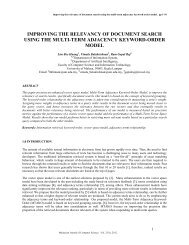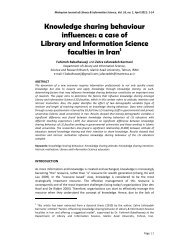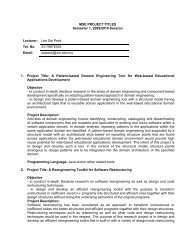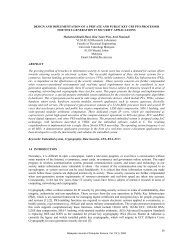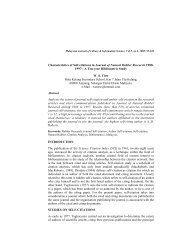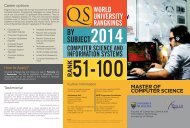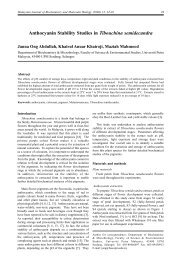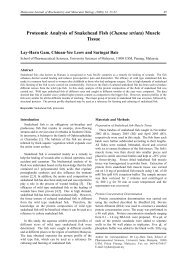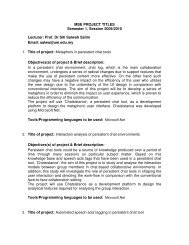Co-authorship network of scientometrics research collaboration - E-LIS
Co-authorship network of scientometrics research collaboration - E-LIS
Co-authorship network of scientometrics research collaboration - E-LIS
- No tags were found...
You also want an ePaper? Increase the reach of your titles
YUMPU automatically turns print PDFs into web optimized ePapers that Google loves.
Erfanmanesh, M.; Rohani, V.A. & Abrizah, A.component <strong>of</strong> the <strong>network</strong> comprises 597 institutions which occupies 49.46% <strong>of</strong> theoverall size <strong>of</strong> the <strong>network</strong>. Institutions not belonging to the main component form 439isolated components, the largest one has only 12 vertices. The mean geodesic distance <strong>of</strong>the <strong>network</strong> is 5.28, suggesting that there are less than six degree <strong>of</strong> separation betweenmost institutions in the <strong>network</strong>. Additionally, the clustering coefficient <strong>of</strong> co-<strong>authorship</strong><strong>network</strong> <strong>of</strong> institutions is 0.623, which means that there is 62.3% chance that twoinstitutions both collaborating with a third institution would also collaborate together.Figure 3: Scientometrics <strong>Co</strong>-<strong>authorship</strong> Network <strong>of</strong> InstitutionsMicro level metrics which include degree centrality, closeness centrality and betweennesscentrality were also calculated for institutions co-<strong>authorship</strong> <strong>network</strong>. Table 2 shows thetop 20 institutions in centrality measures as well as productivity and <strong>collaboration</strong>. Withrespect to degree centrality, the top institutions are: University <strong>of</strong> Leuven (262), HungarianAcademy <strong>of</strong> Science (226), University <strong>of</strong> Antwerp (131), University <strong>of</strong> Granada (107),Katholieke Hogeschool Brugge-Oostende (107), Institute <strong>of</strong> Scientific and TechnicalInformation <strong>of</strong> China (95), Spanish National Research <strong>Co</strong>uncil (82), National Institute <strong>of</strong>Science, Technology and Development Studies (74), Institute for Information andDocumentation in Science and Technology (73) and University <strong>of</strong> Sussex (67). Theseinstitutions with the highest degree centrality are more central to the structure <strong>of</strong> the<strong>network</strong> and tend to have a greater capacity to influence others. The mean degreecentrality across all institutions, including isolates (with degree <strong>of</strong> zero) is 10.92, indicatingthe average number <strong>of</strong> links per institution. For the closeness centrality measure, againUniversity <strong>of</strong> Leuven (0.00163399) and Hungarian Academy <strong>of</strong> Science (0.00163363) takethe top two spots followed by University <strong>of</strong> Sussex (0.00163351), Katholieke HogeschoolBrugge-Oostende (0.00163348), Leiden University (0.00163341), National Institute <strong>of</strong>Science, Technology and Development Studies (0.00163338), University <strong>of</strong> Amsterdam(0.00163334), University <strong>of</strong> Antwerp (0.00163328), Institute <strong>of</strong> Scientific and TechnicalInformation (0.00163328) and Elsevier (0.00163327). Since closeness centrality measuresthe distance <strong>of</strong> an institution to all others in the <strong>network</strong>, the closer the institution is toothers, the more favoured the institution becomes.Page | 82



